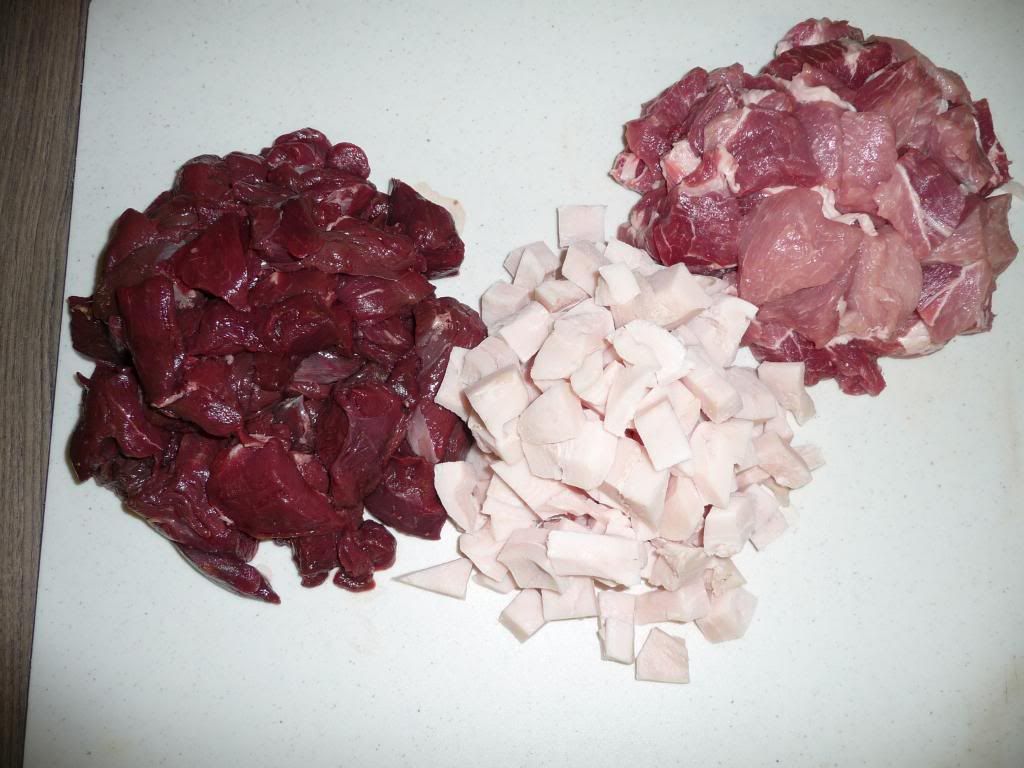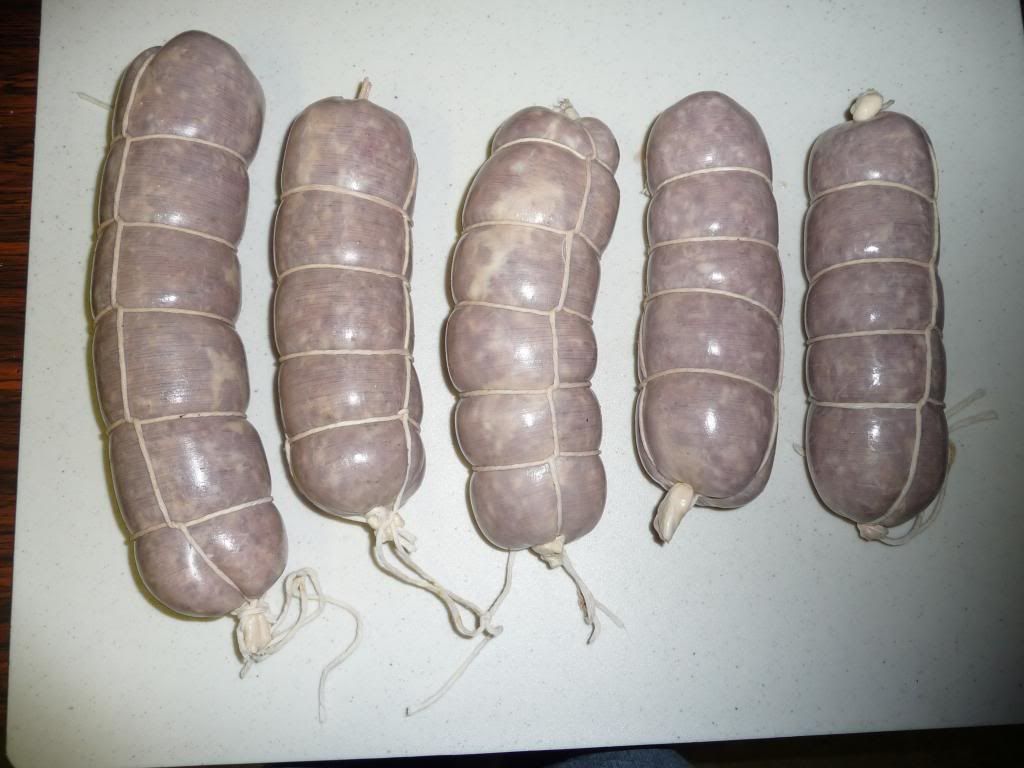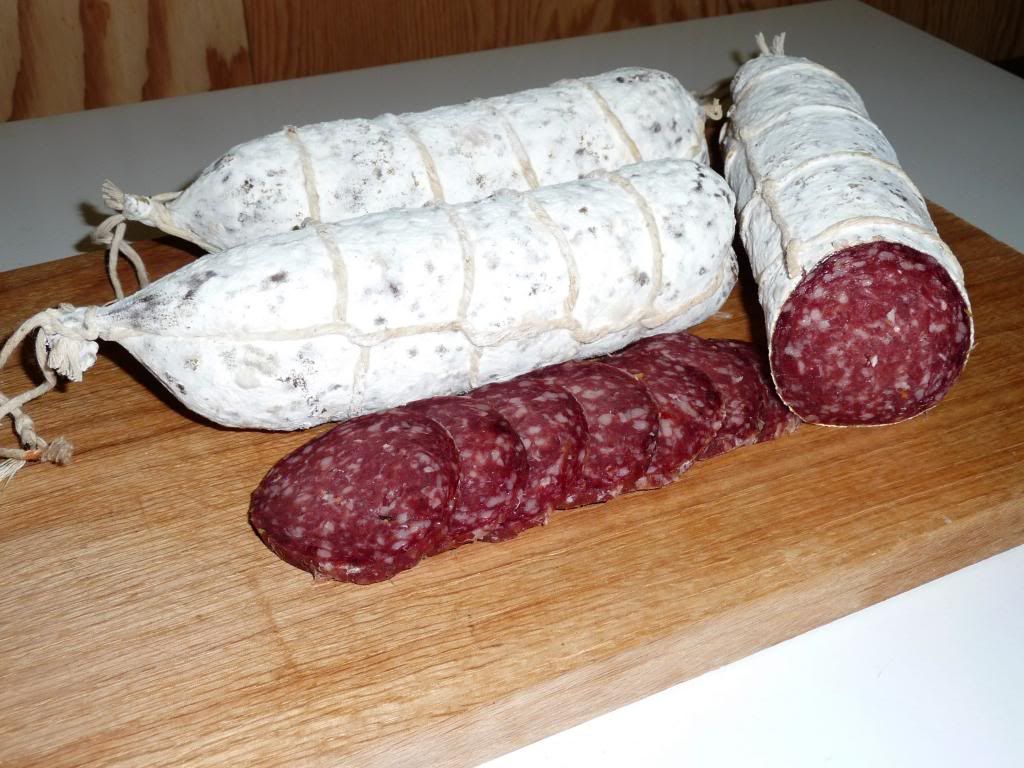Page 1 of 3
Salame di Cervo
Posted: Tue Feb 11, 2014 04:38
by redzed
This past weekend I started a venison salame. Well, it's a venison/pork salame since it's a 50/50 mix. I have some really nice venison in the freezer since last December I helped break down two whitetail carcasses and selected 30 lbs of meat for myself. The meat is impeccably clean and trimmed of sinew, gristle and fat. Lot of guys are really messy when cutting up deer meat, leaving dirt, hair and black dried trim. Making a dry cured product out of that type of meat would pose a considerable amount of risk. The recipe I pulled together is based on a commercial product sold in Italy that originated in Lombardia. Google translated the ingredients for me and I calculated the amounts and am hoping for the best. Since this an experiment, the total amount of the salame weighed just under 3kg. But at this time it looks promising and I am so confident that it will be a success that I am posting the recipe.
Salame di Cervo (Venison Salame)
Ingredients for one kg. of meat
400g. venison
400g. lean pork (I used the sirloin portion of a loin)
200g. hard back fat
22g salt
3g Cure # 2
0.5g sodium erythorbate (optional)
3g. coarse black pepper
1.5g. red pepper flakes
0.5g. cinnamon
0.3g cloves
2.5g garlic powder
3g. dextrose
splash of red wine
Slow or medium fermenting starter culture such as TSP-X or Mondostart Classic.
Salt and cure added to cubed meat, mixed well and placed in fridge for two days. Meat then transferred onto a tray and into the freezer until semi frozen. Everything ground through a 6mm plate, mixed with the remaining spices and wine. Starter culture dissolved in small amount of distilled water with a pinch of dextrose, and added last. Stuffed into beef middles, fermented at 21°C for 48hrs. Starting pH was 5.96 and dropped to 5.05. Will be sprayed with mould starter and transferred into the curing chamber tomorrow.


Posted: Tue Feb 11, 2014 16:10
by Bob K
That sounds like an interesting spice profile Chris!
Venison salame is next on my to try list.
Isn't sodium erythorbate used mainly to reduce nitrate quickly? Just wondering the purpose of adding it to a slow cured product.
Possibly it was in the commercial recipe because they make a fast-fermented product.
Posted: Tue Feb 11, 2014 16:33
by redzed
Good question Bob. The sodium erythorbate might interfere with the slower curing process that I want to achieve, but the reason that I added it is to retain the red colour. Lately my salamis have been on the brownish side which is not that visually appealing. That is why I also cured the cubed meat for two days before grinding and stuffing. And I probably should have used ordinary sucrose (white table sugar) rather than sucrose in the form of corn syrup solids, since that apparently also affects the colour.
Posted: Tue Feb 11, 2014 17:06
by Bob K
Chris-
I think the antioxidants like ascorbic acid and sodium erythorbate would work better to retain color in products that are heated or cooked.
I know vitamin C (ascorbic acid) works well to retain color in home canned products.
I think your pre-curing the meat will help with the color but just remember venison is dark by nature and at best will come out a dark maroon color.
That pre-cured firm meat grinds very nicely!
Posted: Tue Feb 11, 2014 20:41
by alhunter63
Chris,
Why the bactoferm F-LC VS the T-SPX? I thought for a slower curring product that the T-SPX was the preferred choice. By the way, everything looks great and I can't wait to see how everything turns out. I'd like to use more venison in my stuff considering how much I get every year between archery & regular season.
Angelo
Posted: Wed Feb 12, 2014 02:47
by redzed
alhunter63 wrote:Chris,
Why the bactoferm F-LC VS the T-SPX? I thought for a slower curring product that the T-SPX was the preferred choice. By the way, everything looks great and I can't wait to see how everything turns out. I'd like to use more venison in my stuff considering how much I get every year between archery & regular season.
Angelo
T-SPX might have been a better choice but I had an unopened package of F-LC that I bought a year ago, so better use it. At the same time, F-LC is a versatile preparation, since you can ferment with it at a higher temp and get the tang, or ferment at a lower temp, cure longer and get the milder traditional taste. For someone who does not do large amounts of dry products, it makes sense to buy it.
Posted: Tue Apr 01, 2014 18:10
by redzed
Salame di Cervo after seven weeks of drying. Took a bit longer than usual but the humidity in the chamber was a bit elevated because I had been continually adding product. I am very happy with the results. It dried evenly, does not crumble and best of all the flavour is wonderful, almost exotic with hints of Morocco. I still have some first class venison trimmings in the freezer and will be making more soon.

Posted: Wed Apr 02, 2014 16:54
by Bob K
Chris-
That looks wonderful! Especially the color.
Do you think the sodium erythorbate contributed to that? Venison contributes also compared to beef.
Bob
Posted: Wed Apr 02, 2014 19:32
by redzed
Bob, I really have how much of a role the s. erythorbate played in achieving the colour. Just about everything is top drawer with this salami. Maybe its just a fluke!

Recently I also had a major failure in trying to make a 2kg. coppatta. Even though it seemed to ferment OK, the meat never bonded, was soft even though it lost 50% of weight and tasted rancid.
Posted: Wed Apr 02, 2014 19:47
by sawhorseray
"redzed" wrote:
I am very happy with the results
How could you not be thrilled with that, it's the best I've ever laid eyes on, superb effort! RAY
Posted: Fri Apr 04, 2014 19:32
by Igor Duńczyk
I so much like the color of your Salame di Cervo and my bet is that it will remain very stable until the last slice. If that will be the case I´d say that you can thank the sodium erythorbate (or iso ascorbate -which I think sounds more human

). Anyway, I would never leave it out of any recipe which includes cure.
How do you rate the taste when using F-LC as opposed to T-SPX ?
Posted: Fri Apr 04, 2014 20:03
by redzed
Difficult to compare F-LC to T-SPX, since I have never used the latter in this recipe. But as far as the F-LC, even though I had a fast pH drop during the initial fermentation, it worked well. There is very good binding and no detectable sour flavour. I have a bit of T-SPX left, so I will try it in my next batch. I'm working this month

so I have no time to dedicate to my hobbies these days.
Posted: Thu May 08, 2014 11:59
by Dave Zac
That Salame looks incredible. Noooo comparison with your method and and cured meat with the Umai bag. I may have found a way to fridge cure, but the standard method in this case will always win out. Stupendous indeed.
Posted: Thu May 08, 2014 20:42
by redzed
Thanks Dave. The Salami is long gone and everyone who tasted it liked it. I will be making another batch using exactly the same recipe. This was one of my rare experiments where everything went well the first time. I crafted the recipe myself, based on this information I found on an Italian site.
http://www.prodottitipici.com/prodotto/ ... -cervo.htm
I hope to try the umai bags one of these days. And while they obviously are not a total replacement for a curing chamber, it is another way to create a very decent dry cured product.
Posted: Fri May 09, 2014 00:09
by tobertuzzi
Looks awesome Chris, I was looking for sodium erythorbate locally. Stuffers doesn't list it. Where did you get yours from? The sausage maker has it but with the Canadian dollar these days it starts to get pricey. I might have to try your recipe with moose.
Thanks
Toby




